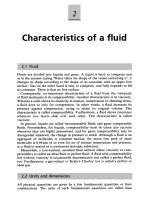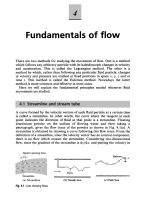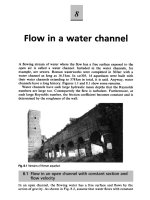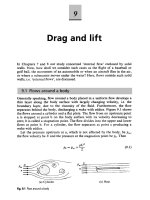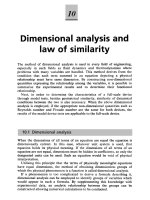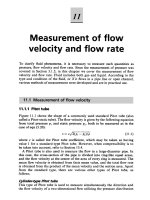Introduction to Continuum Mechanics 3 Episode 11 pptx
Bạn đang xem bản rút gọn của tài liệu. Xem và tải ngay bản đầy đủ của tài liệu tại đây (1.19 MB, 40 trang )
386
Energy Equation
For a
Newtonian
Fluid
which
in
this problem reduces
to
Thus,
and
Using
the
boundary condition
0 =
©/
at y = 0 and © =
©
M
at y =
d,
the
constants
of in-
tegration
are
determined
to be
d®
It
is
noted here that when
the
values
of © are
prescribed
on the
plates,
the
values
of
-r-
on
the
plates
are
completely determined.
In
fact,
— =
(©
u
-©/)/<£
This serves
to
illustrate
that,
in
steady-state heat conduction problem (governed
by the
Laplace equation)
it is in
general
not
possible
to
prescribe
both
the
values
of
0
and the
normal derivatives
of © at the
same points
of the
complete boundary unless
they
happen
to be
consistent
with
each other.
Example
6.18.2
The
plane Couette
flow is
given
by the
following
velocity
distribution:
If
the
temperature
at the
lower plate
is
kept
at
©/
and
that
at the
upper plate
at
Q
n
,
find
the
steady- state temperature distribution.
Solution.
We
seek
a
temperature
distribution
that
depends
only
on y.
From
Eq.
(6.18.3),
we
have, since
D\2
=
k/2
Newtonian
Viscous
Fluid
387
Thus,
which
gives
where
C\
and
€2
are
constants
of
integration.
Now at y = 0, 0 =
0/
and at y
=
d,
& =
Q
u
,
therefore,
The
temperature distribution
is
therefore
given
by
6.19
Vorticity
Vector
We
recall
from
Chapter
3,
Section
3.13
and 14
that
the
antisymmetric part
of the
velocity
gradient
(Vv)
is
defined
as the
spin tensor
W.
Being
antisymmetric,
the
tensor
W
is
equivalent
to a
vector
to in the
sense that
Wx
=
at
x x
(see Sect.
2B16).
In
fact,
Since
(see
Eq.
(3.14.4),
the
vector
at is the
angular velocity vector
of
that part
of the
motion,
representing
the rigid
body
rotation
in the
infinitesimal
neighborhood
of a
material point. Further,
o>
is the
angular
velocity
vector
of the
principal axes
of D,
which
we
show
below:
Let
dx
be a
material element
in the
direction
of the
unit vector
n
at
time
t.,
i.e.,
where
ds is the
length
of
dx.
Now
But,
from
Eq.
(3.13.6)
of
Chapter
3, we
have
388
Vorticity Vector
Using
Eq.
(6.19.1)
and
(ii)
,Eq.
(i)
becomes
Now,
if
n
is an
eigenvector
of D,
then
and
and
Eq.
(6.19.3)
becomes
which
is the
desired result.
Eq.
(6.19.6)
and Eq.
(6.19.1)
state that
the
material elements which
are in the
principal
directions
of D
rotate with angular
velocity
a>
while
at the
same time changing their lengths.
In
rectangular
Cartesian
coordinates,
Conventionally,
the
factor
of 1/2 is
dropped
and one
defines
the
so-called vorticity vector
£
as
The
tensor
2W is
known
as the
vorticity tensor.
It
can be
easily seen that
in
indicial notation,
the
Cartesian components
of?
are
and in
invariant notation,
In
cylindrical coordinates
(r,0,z)
Newtonian
Viscous
Fluid
389
In
spherical coordinates
(r,Q,<p)
Example
6.19.1
Find
the
vorticity
vector
for the
simple shearing
flow:
Solution.
We
have
and
That
is,
We see
that
the
angular velocity vector
(=
5
/ 2) is
normal
to the
jcj
x^
plane
and the
minus
sign simply means that
the
spinning
is
clockwise looking
from
the
positive side
ofx$.
Example
6.19.2
Find
the
distribution
of the
vorticity vector
in the
Couette
flow
discussed
in
Section
6.15.
Solution.
Withv
r
=
v
z
—
0
andv#
=
Ar+(B/r).
It is
obvious that
the
only
nonzero
vorticity
component
is in the 2
direction.
From
Eq.
(6.19.11),
390
irrotational
Flow
6.20 Irrotational Flow
If
the
vorticity
vector
(or
equivalently,
vorticity
tensor)
corresponding
to a
velocity
field,
is
zero
in
some region
and for
some time interval,
the flow is
called irrotational
in
that region
and
in
that
time interval.
Let
<P(XI,
x
2
,
*3,
t) be a
scalar
function
and let the
velocity components
be
derived
from
<p
by
the
following equation:
i.e.,
Then
the
vorticity component
and
similarly
That
is, a
scalar
function
<P(XI,
x
2
,
x$,
t)
defines
an
irrotational
flow
field
through
the
Eq.
(6.20.2).
Obviously,
not all
arbitrary
functions
<p
will give rise
to
velocity fields that
are
physically
possible.
For one
thing,
the
equation
of
continuity, expressing
the
principle
of
conservation
of
mass, must
be
satisfied.
For an
incompressible
fluid,
the
equation
of
continuity
reads
Thus, combining
Eq.
(6.20.2)
with
Eq.
(6.20.3),
we
obtain
the
Laplacian
equation
for
<f>,
i.e.,
Newtonian
Viscous
Fluid
391
In the
next
two
sections,
we
shall discuss
the
conditions under
which
irrotational
flows
are
dynamically
possible
for an
inviscid
and
viscous
fluid.
6.21 Irrotational Flow
of an
Inviscid
Incompressible
Fluid
of
Homogeneous
Density
An
inviscid
fluid is
defined
by
obtained
by
setting
the
viscosity
fi
=
0
in
the
constitutive
equation
for
Newtonian viscous
fluid.
The
equations
of
motion
for an
inviscid
fluid are
or
Equations
(6.21.2)
are
known
as the
Euler's
equation
of
motion.
We now
show that irrotationai
flows are
always dynamically
possible
for an
inviscid,
incompressible
fluid
with
homogeneous
density provided that
the
body forces acting
are
derivable
from
a
potential
Q
by the
formulas:
For
example,
in the
case
of
gravity force,
with
x$
axis
pointing vertically upward,
so
that
Using
Eq.
(6.21.3),
and
noting
thatp
=
constant
for a
homogeneous
fluid. Eq.
(6.21.2)
can
be
written
as
For an
irrotational
flow
so
that
392
Irrotational
Flow
of an
Inviscid Incompressible Fluid
of
Homogeneous Density
O
*J
I
*\
where
v
=
vf+V2+V3
is the
square
of the
speed. Therefore
Eq.
(6.21.6)
becomes
Thus
where
f(t)
is an
arbitrary
function
oft.
If
the flow is
also steady then
we
have
Equation
(6.21.8)
and the
special case
(6.21.9)
are
known
as the
Bernoulli's
equations.
In
addition
to
being
a
very useful formula
in
problems where
the
effect
of
viscosity
can be
neglected,
the
above derivation
of the
formula shows that
irrotational
flows are
always
dynamically
possible
under
the
conditions stated earlier.
For
whatever function
#?,
so
long
as
d<f)
2
v,
=
-~
and V
<p
= 0, the
dynamic equations
of
motion
can
always
be
integrated
to
give
OXf
Bernoulli's
equation
from
which
the
pressure distribution
is
obtained, corresponding
to
which
the
equations
of
motion
are
satisfied.
Example
6.21.1
Given
<p=x
3
-3xy
2
.
(a)
Show that
<p
satisfies
the
Laplace equation.
(b)
Find
the
irrotational velocity
field.
(c)
Find
the
pressure distribution
for an
incompressible homogeneous
fluid, if at
(0,0.0)
p
=p
0
and
Q=gz.
(d) If the
plane
y
—
0 is a
solid boundary,
find
the
tangential component
of
velocity
on the
plane.
Solution,
(a) We
have
Newtonian
Viscous
Fluid
393
therefore,
d<f>
(b)
From
v/
=
—jr-,
we
have
1
(c) We
have,
at
(0,0,0),
v
1
= 0,
v
2
=
0,
v
3
= 0, p =
p
0
,
and
Q
= 0
therefore,
from
the
Bernoulli's equation, [Eq.
(6.21.9)]
we
have
and
or
(d)
On the
plane
y - 0,
vj
=
-3x
2
and
v
2
= 0.
Now,
v^
- 0
means that
the
normal com-
ponents
of
velocity
are
zero
on the
plane,
which
is
what
it
should
be
if
y = 0 is a
solid
fixed
boundary.
Since
vi
=
-3*
2
,
the
tangential components
of
velocity
are not
zero
on the
plane,
that
is, the
fluid slips
on the
boundary.
In
inviscid
theory,
consistent
with
the
assumption
of
zero
viscosity,
the
slipping
of fluid on a
solid boundary
is
allowed. More discussion
on
this
point will
be
given
in the
next section.
Example
6.21.2
A
liquid
is
being drained through
a
small opening
as
shown. Neglect viscosity
and
assume
that
the
falling
of the
free surface
is so
slow that
the flow can be
treated
as a
steady one. Find
the
exit speed
of the
liquid
jet as a
function
of
h.
394
Irrotational
Flows
as
Solutions
of
Navier-Stokes
Equation
Solution.
For a
point
on the
free surface such
as the
point
A, p
-p
0
,
v
«
0 and z =
h.
Therefore,
from
Eq.
(6.21.9)
At
a
point
on the
exit
jet, such
as the
point
5,
z = 0
and/?
=
p
0
.
Thus,
from
which
This
is the
well known
Torricelli's
formula.
Fig.
6.13
6.22
Irrotational
Flows
as
Solutions
of
Navier-Stokes
Equation
For an
incompressible Newtonian
fluid, the
equations
of
motion
are the
Navier-Stokes
equations:
For
irrotational
flows
Newtonian
Viscous
Fluid
395
so
that
.2
But,
from
Eq.
(6.20.4)
,
f
= 0.
Therefore,
the
terms
involving
viscosity
in the
Navier-
n
BxjdXj
Stokes equation drop
out in the
case
of
irrotational
flows
so
that
the
equations take
the
same
form
as the
Euler's
equation
for an
inviscid
fluid.
Thus,
if the
viscous
fluid has
homogeneous
density
and if the
body
forces
are
conservative
(i.e.,
B/
=
~"^~~)>
tne
results
of the
last sections
ax;
show
that irrotational
flows are
dynamically
possible also
for a
viscous
fluid.
However,
in any
physical
problems, there
are
always
solid boundaries.
A
viscous
fluid
adheres
to the
boundary
so
that both
the
tangential
and the
normal components
of the fluid
velocity
at the
boundary
should
be
those
of the
boundary. This means that both velocity components
at the
boundary
are to be
prescribed.
For
example,
if
v
=
0 is a
solid boundary
at
rest,
then
on the
boundary,
the
tangential components,
v
x
~v
z
=
0, and the
normal components
v
y
= 0. For
irrotational
flow, the
conditions
to be
prescribed
for
<p
on the
boundary
are
<f>
=
constant
aty = 0
(so
that
d<p
v
x
=
v
z
~
0)
and
-^-
= 0 at y - 0. But it is
known
(e.g.,
see
Example
6.18.1,
or
from
the
potential theory) that
in
general there does
not
exist
solution
of the
Laplace equation
satisfying
both
the
conditions
<p
-
constant
and
V#>
•
n
=
-*-
= 0 on the
complete
boundaries.
There-
fore,
unless
the
motion
of
solid boundaries happens
to be
consistent with
the
requirements
of
irrotationality,
vorticity
will
be
generated
on the
boundary
and
diffuse
into
the flow field
according
to
vorticity equations
to be
derived
in the
next section. However,
in
certain
problems under suitable conditions,
the
vorticity generated
by the
solid boundaries
is
confined
to a
thin layer
of fluid in the
vicinity
of the
boundary
so
that outside
of the
layer
the flow is
irrotational
if it
originated
from
a
state
of
irrotationality.
We
shall have more
to say
about this
in
the
next
two
sections.
Example
6.22.1
For the
Couette
flow
between
two
coaxial
infinitely
long cylinders,
how
should
the
ratio
of
the
angular velocities
of the two
cylinders
be, so
that
the
viscous
fluid
will
be
having irrotational
flow?
Solution.
From Example 19.2
of
Section
6.19,
the
only
nonzero vorticity component
in the
Couette
flow is
where
Q,
denotes
the
angular
velocities.If
fi^-Qiri = 0, the flow is
irrotational. Thus,
396
Vorticity
Transport
Equation
for
Incompressible
Viscous
Fluid
with
a
Constant
Density
It
should
be
noted that even
though
the
viscous
terms drop
out
from
the
Navier-Stokes
equations
in the
case
of
irrotational
flows, it
does
not
mean that there
is no
viscous dissipation
in
an
irrotational
flow of a
viscous
fluid. In
fact,
so
long
as
there
is one
nonzero rate
of
deformation component, there
is
viscous dissipation [given
by Eq.
(6.17.4)]
and the
rate
of
work
done
to
maintain
the
irrotational
flow
exactly
compensates
the
viscous dissipations.
6.23 Vorticity Transport Equation
for
Incompressible
Viscous
Fluid
with
a
Constant Density
In
this section,
we
derive
the
equation governing
the
vorticity
vector
for an
incompressible
homogeneous viscous
fluid.
First,
we
assume that
the
body force
is
derivable
from
a
potential
BQ
dQ
Q
,
i.e.,
B;
=
——.
Now,
with/?
=
constant
and B; =
——,
the
Navier-Stokes equation
can
dx;
dXj
n
be
written
where
v
~
p/p
is
called
the
kinematic
viscosity.
If
we
operate
on Eq.
(6.23,1)
by the
differential
operator
e
mm
——
[i.e, taking
the
curl
of
both sides
of Eq.
(6.23.1)].
We
have, since
ox
n
and
The
Navier-Stokers equation therefore,
takes
the
form
Newtonian
Viscous
Fluid
397
dv
m
We
now
show that
the
third term
on the
left-hand
side
is
equal
to
—£„.
OX
n
From
Eq.
(6.19.9),
we
have
Thus,
But
it can be
easily
verified
that
for any
A^
e
mni
Aj^4ji
~
0»
tnus
and
since
e
mn
/
e
pji
=
(d
mp
d
nj
-(5
m
/5
n/
,)[see
Prob.
2A7]
dv
n
where
we
have used
the
equation
of
continuity
-—
= 0.
Therefore,
we
have
QJC»t
or,
which
can be
written
in the
following
invariant
form:
where
398
Vorticrty
Transport
Equation
for
Incompressible
Viscous
Fluid
with
a
Constant
Density
Reduce,
from
Eq.
(6.23.5)
the
vorticity
transport equation
for the
case
of
two-dimensional
flow.
Solutions.
Let the
velocity
field
be:
Then
becomes
That
is, the
angular velocity vector(
£ / 2) is
perpendicular
to the
plane
of flow as
expected.
Now,
Thus,
Eq.
(6.23.5)
reduces
to the
scalar equation
where
Newtonian Viscous
Fluid
399
Example
6.23.2
The
velocity
field
for the
plane
Poiseuille
flow
is
given
by
\ /
(a)
Find
the
vorticity components.
(b)
Verify
that
Eq.
(6.23.6)
is
satisfied.
Solution.
The
only nonzero vorticity component
is
(b) We
have, letting
£
3
= £
and
so
that
Eq.
(6.23.6)
is
satisfied.
6.24
Concept
of a
Boundary
Layer
In
this section
we
shall describe, qualitatively,
the
concept
of
viscous boundary layer
by
means
of an
analogy.
In
Example
6.23.1,
we
derived
the
vorticity equation
for
two-dimensional
flow
of
an
incompressible
viscous
fluid to be the
following:
where
£ is the
only nonzero vorticity component
for the
two-dimensional
flow and v is
kinematic viscosity
(v
=p/p).
In
Section
6.18
we saw
that,
if the
heat generated through viscous dissipation
is
neglected,
the
equation
governing
the
temperature
distribution
in the flow
field
due to
heat conduction
through
the
boundaries
of a hot
body
is
given
by
[Eq.
(6.18.4)]
400
Concept
of a
Boundary
Layer
where
0
is
temperature
and
«,
the
thermal
diffusivity,
is
related
to
conductivity
/c,
density
p
and
specific heat
per
unit mass
c by the
formulas
a =
K/pc.
Suppose
now we
have
the
problem
of a
uniform
stream
flowing
past
a hot
body whose
temperature
in
general varies along
the
boundary.
Let the
temperature
at
large distance
from
the
body
be
Ooo,
then
defining
0'
=
B-Q^,
we
have
with
©'
= 0 at x
+y
2
-*
°°.
On the
other hand,
the
distribution
of
vorticity
around
the
body
is
governed
by
2 2
with£
=
Oat
x +y
-»«>,
where
the
variation
of
£,
being
due to
vorticity
generated
on the
solid
boundary
and
diffusing
into
the
field,
is
much
the
same
as the
variation
of
temperature, being
due to
heat
diffusing
from
the hot
body into
the
field.
Fig.
6.14
Now,
it is
intuitively clear that
in the
case
of the
temperature distribution,
the
influence
of the
hot
temperature
of the
body
in the
field
depends
on the
speed
of the
stream.
At
very
low
speed,
conduction
dominates over
the
convection
of
heat
so
that
its
influence will extend
deep
into
the
fluid in all
directions
as
shown
by the
curve
C\
in
Fig.
6.14,
whereas
at
high
speed,
the
heat
is
convected
away
by the fluid so
rapidly that
the
region
affected
by the hot
body will
be
confined
to a
thin layer
in the
immediate neighborhood
of the
body
and a
tail
of
heated
fluid
behind
it, as is
shown
by the
curve
C^
in
Fig. 6.14.
Newtonian
Viscous
Fluid
401
Analogously,
the
influence
of
viscosity,
which
is
responsible
for the
generation
of
vorticity
on the
boundary, depends
on the
speed
U
m
far
upstream.
At low
speed,
the
influence
will
be
deep
into
the
field
in all
directions
so
that essentially
the
whole
flow
field
is
having vorticity.
On the
other hand,
at
high
speed,
the
effect
of
viscosity
is
confined
in a
thin
layer
(
known
as
a
boundary layer)
near
the
body
and
behind
it.
Outside
of the
layer,
the flow is
essentially
irrotational.
This
concept enables
one to
solve
a fluid flow
problem
by
dividing
the flow
region
into
an
irrotational
external
flow
region
and a
viscous boundary layer. Such
a
method
simplifies
considerably
the
complexity
of the
mathematical problem involving
the
full
Navier-Stokes
equations.
We
shall
not go
into
the
methods
of
solution
and of the
matching
of the
regions
as
they
belong
to the
boundary layer theory.
6.25
Compressible
Newtonian
Fluid
For a
compressible
fluid, to be
consistent
with
the
state
of
stress corresponding
to the
state
of
rest
and
also
to be
consistent
with
the
definition
that/?
is not to
depend explicitly
on any
kinematic quantities when
in
motion,
we
shall regard
p as
having
the
same value
as the
thermodynamic
equilibrium pressure. Therefore,
for a
particular
density
p and
temperature
0, the
pressure
is
determined
by the
equilibrium
equation
of
state
For
example,
for an
ideal
gas/?
=
Rp®.
Thus
Since
it
is
clear that
the
"
pressure"
p in
this case does
not
have
the
meaning
of
mean normal
compressive
stress.
It
does
have
the
meaning
if
which
is
known
to be
true
for
monatomic gases.
2
Written
in
terms
of
ju
and k =
A+-ju,
the
constitutive equation reads
«.?
With
TIJ
given
by the
above equation,
the
equations
of
motion become
(assuming
constant
ju
andk)
402
Energy
Equation
in
Terms
of
Enthalpy
Equations
(6.25.1)
and
(6.25.6)
are
four
equations
for six
unknowns
v
1?
v^, v^,
p, p, 0; the
fifth
equation
is
given
by the
equation
of
continuity
and
the
sixth equation
is
supplied
by the
energy equation
where
Ty
is
given
by Eq.
(6.25.5)
and the
dependence
of the
internal energy
u
onp
and
@
is
assumed
to be the
same
as
when
the
fluid
is in the
equilibrium state,
for
example,
for
ideal
gas
where
c
v
is the
specific heat
at
constant volume.
In
general,
we
have
Equations
(6.25.1),(6.25.6),(6.25.7),(6.25.8),
and
(6.25.10)
form
a
system
of
seven scalar equa-
tions
for the
seven unknowns
vj,
V2>
V
3»P»
A
®>
an
^
u
>
6.26
Energy
Equation
in
Terms
of
Enthalpy
Enthalpy
per
unit mass
is
defined
as
where
u is the
internal energy
per
unit
mass,/?
the
pressure,p
the
density.
Let
h
0
=
h+v
/2,
(h
0
is
known
as the
stagnation enthalpy).
We
shall show that
in
terms
of
h
0
,
the
energy
equation
becomes (neglecting body forces)
where
7^'
is the
viscous stress tensor,
q
f
the
heat
flux
vector. First,
by
definition,
From
the
energy equation [Eq.
(6.18.1)],
with
q
s
= 0, we
have
Newtonian
Viscous
Fluid
403
Also,
we
have
and
the
equation
of
motion
(in
the
absence
of
body forces)
Thus,
Noting that
and
we
have,
or,
which
is
Equation
(6.26.2).
Example
6.26.1
Show
that
for
steady
flow of an
inviscid
non-heat conducting
fluid, if the flow
originates
from
a
homogeneous
state,
then
(a)
h+(v
2
/2}
=
constant,
and
(b) if the fluid is an
ideal
gas
then
404
Acoustic
Wave
where
y =
c
p
/c
v
,
the
ratio
of
specific
heat under constant pressure
and
constant volume.
Solution,
(a)
Since
the flow is
steady, therefore,
dp/dt
= 0.
Since
the fluid is
inviscid
and
non-heat conducting, therefore
Ty
'=
0
and<?/
= 0.
Thus,
the
energy equation (6.26.2) reduces
to
In
other words,
h
0
is a
constant
for
each particle.
But
since
the flow
originates
from
a
homogeneous state, therefore
in
the
whole
flow
field.
(b)
For an
ideal
gasp
=
pR®,
u =
c
v
Q,
and
R -
c
p
-c
v
,
therefore
where
and
6.27
Acoustic
Wave
The
propagation
of
sound
can be
approximated
by
considering
the
propagation
of in-
finitesimal
disturbances
in a
compressible
inviscid
fluid. For an
inviscid
fluid,
neglecting body
forces,
the
equations
of
motion
are
Let us
suppose that
the fluid is
initially
at
rest
with
Newtonian
Viscous
Fluid
405
Now
suppose that
the fluid is
perturbed
from
rest
such
that
Substituting
Eq,
(6.27.3)
into
Eq.
(6.27.1),
Since
we
assumed infinitesimal disturbances,
the
terms
vy'(dv/'/cbty)
andp'/p
0
are
negligible
and the
equations
of
motion
now
take
the
linearized
form
In a
similar manner,
we
consider
the
mass conservation equation
and
obtain
the
linearized equation
Differentiating
Eq.
(6.27.4)
with
respect
to
jt/and
Eq.
(6.27.5)
with
respect
to
?,
we
eliminate
the
velocity
to
obtain
We
further assume that
the flow is
barotropic, i.e.,
the
pressure depends explicitly
on
density
only,
so
that
the
pressure/?
=
p(p}.
Expandingp(p}
in a
Taylor
series
about
the
rest
value
of
pressure
p
0
,
we
have
Neglecting
higher-order terms
where
406
Acoustic
Wave
Thus,
for a
barotropic
fluid
and
These
equations
are
exactly analogous (for one- dimensional waves)
to the
elastic wave
equations
of
Chapter
5.
Thus,
we
conclude that
the
pressure
and
density disturbances
will
propagate with
a
speed
c
0
=
^(dp/dp)
p
. We
call
c
0
the
speed
of
sound
at
stagnation,
the
local
speed
of
sound
is
defined
to be
When
the
isentropic
relation
ofpand/o
is
used, i.e.,
where
y =
c
p
/c
v
(
ratio
of
specific
heats)
and/?
is a
constant
so
that
the
speed
of
sound
is
(a)
Write
an
expression
for a
harmonic plane acoustic wave propagating
in the
ej
direction.
(b)
Find
the
velocity disturbance
vj.
(c)
Compare
dv/dt
to the
neglected
vydv/
/
dx;.
Solution.
In the
following
,p,
p,
vj
denote
the
disturbances, that
is, we
will
drop
the
primes,
(a)
Referring
to the
section
on
elastic waves,
we
have
(b)
Using
Eq.
(6.27.4),
we
have
Newtonian
Viscous
Fluid
407
Therefore,
the
velocity disturbance
is
exactly
the
same
form
as the
pressure wave.
(c) For the
one-dimensional case,
we
have
the
following
ratio
of
amplitudes
Thus,
the
approximation
is
best when
the
disturbance
has a
velocity that
is
much smaller than
the
speed
of
sound.
Example
6.27.2
Two
fluids
have
a
plane interface
at
x\
= 0.
Consider
a
plane acoustic wave that
is
normally
incident
on the
interface
and
determine
the
amplitudes
of the
reflected
and
transmitted waves.
Solution.
Let the fluid
properties
to the
left
of the
interface
(#i<0)
be
denoted
by
PI,CI,
and to the right
(ri>Q)
by
p2>
c
2-
Now,
let the
incident pressure wave propagate
to the
right,
as
given
by
This pressure wave results
in a
reflected wave
and
a
transmitted wave
We
must
now
consider
the
conditions
on the
boundary
jcj
= 0.
First,
the
total pressure must
be the
same,
so
that
or,
408
irrotational,
Barotropic
Flows
of
Inviscid
Compressible
Fluid
This equation
will
be
satisfied
for all
time
if
and
In
addition,
we
require
the
normal
velocity
be
continuous
at all
time
on
x\
= 0, so
that
ftoi]
—r~
, is
also continuous. Thus,
by
using
Eq.
(6.27.4),
\
dt
!
Xl
=
o
Substituting
for the
pressure,
we
obtain
Combining Eqs. (vi)
(vii)
and
(ix)
we
obtain
Note that
for the
special
casep^i
=
p-f^
This
productpc
is
referred
to as the
"fluid
impedance". This result shows that
if
the
impedances
match,
there
is no
reflection.
6.28 Irrotational, Barotropic Flows
of
Inviscid
Compressible
Fluid
Consider
an
irrotational
flow
field
given
by
Newtonian
Viscous
Fluid
409
To
satisfy
the
mass conservation principle,
we
must
have
In
terms
of
<p
this equation becomes
The
equations
of
motion
for an
inviscid
fluid are the
Euler
equations
We
assume that
the flow is
barotropic, that
is, the
pressure
is an
explicit
function
of
density
only
(such
as in
isentropic
or
isothermal
flow).
Thus,
in a
barotropic
flow,
Now,
Therefore,
for
barotropic
flows of an
inviscid
fluid
under conservative body forces (i.e.,
<3Q
».
-
—__^
the
equations
of
motion
can be
written
oX{
Comparing
Eq.
(6.28.7)
with
(6.21.6),
we see
immediately that under
the
conditions
stated,
irrotational
flows are
again
always
dynamically
possible.
In
fact,
the
integration
of Eq.
(6.28.7)
(in
exactly
the
same
way as was
done
in
Section 6.21) gives
the
following Bernoulli equation
which
for
steady
flow,
becomes
For
most problems
in gas
dynamics,
the
body
force
is
small
compared
with
other forces
and
often
neglected.
We
then have
410
Irrotational,
Barotropic
Flows
of
Inviscid
Compressible
Fluid
Example
6.28.1
Show
that
for
steady isentropic
irrotational
flows
of an
inviscid
compressible
fluid
(body
force
neglected)
Solution.
For an
isentropic
flow
so
that
Thus,
the
Bernoulli equation [Eq.
(6.28.11)]
becomes
We
note
that this
is the
same result
as
that
obtained
in
Example 26.1,
Eq.
(6.26.8),
by the use
of
the
energy
equation.
In
other words, under
the
conditions stated (inviscid, non-heat
conducting, initial homogeneous state),
the
Bernoulli equation
and the
energy equation
are
the
same.
Example
6.28.2
Let
p
0
denote
the
pressure
at
zero speed (called stagnation pressure
.)
Show that
for
isentropic steady
flow
(p/p
Y
=
constant)
of an
ideal gas,
where
c is the
local speed
of
sound.
Solution.
Since (see
the
previous example)
therefore,
